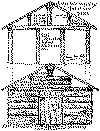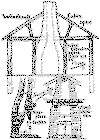by Ernest Thompson Seton
When Moses instituted the Feast of Tabernacles and started the world out on an annual camping trip he undoubtedly had several good reasons in the back of his mind. I imagine the smallest of them was in reference to the very poor but necessary trip that his people, "his forty-niners", made across the plains.
The most important part of it all probably was the complete hark back to the primitive. His people were told to put on wilderness clothes, eat wilderness food, dwell in wilderness tabernacles, and live the wilderness life their fathers had done in the desert.
The resumption of simple life was essential--this elimination of the middleman-the masterful contact of the man with wild nature--this elemental face to face of man and the wilds.
I am sure this is the most valuable thing in it and when I see a New York family building a Fifth Avenue mansion in the Adirondacks, then nailing a few slabs on the outside and calling it a "camp"--I marvel at their poverty. It does not surprise me when I learn that they add tennis, billiards, moving pictures, etc., to relieve their boredom. It does not surprise me but it fills me with sorrow.
Let us face the matter frankly. There are certain great benefits and certain great dangers in camp life. It is the leader's job to get all the good for his band and dodge all the evil.
The good things are the sun-and-air life, the calm, the sweetness of the night, and the total change of thought and home world. This last is maybe the best of all, yet the one that some campers are deliberately leaving out.
It seems to me that we should begin our camping plans by leaving out everything unnecessary that we can get at home or in town-mansions with oriental fittings, electric lights, gramophones, yes baseball and tennis as well as billiards, motor boats and motor cars, because we can get them elsewhere. They belong to another life.
For the complete hark back we have two usual plans. One, the wilderness traveling trip in which we are perforce tied to dog-tents and one-night stands. This is very close to ideal. But a much larger number are limited to the permanent camp, and it is for these especially that this message is meant.
As long as your permanent camp is of real tents or tepees and close to the ground and hallowed with wood smells, you are getting the big good thing. But as soon as you begin to floor your tent and set up over it a permanent frame and roof, you have taken a step back toward town, a step that will rob you of some good things.
It is for these that the Woodcraft cabin was built and is now recommended.
For full practical application each gang should as far as possible make their own camp out of material secured by themselves from the surrounding woods or country. A leader is needed who is artistic as well as constructive, and has Woodcraft instincts, because from the very nature of it every camp must be a separate proposition. In Maine, we are free to cut and use all the soft timber we want. In Carolina it would be more or less of stone, but in Texas there is no choice but "Dobies."
The Woodcraft cabin is full of the beauty of the things that grow. It has the glorious smell and magic of the woods. Its every feature stands for a little triumph of the owners over the wide world about. It has all the charms of beauty, personality, conquest and romance. The very fact that everything in it was made by the owners' hands lends a consecration that cannot be got in any other way. Last and largest, it may be blessed with the crowning glory, an open fire.
The cabin may, in short, be a wonderful spiritual experience that the bungalow or house can scarcely be.
But all of this is providing that the cabin be of true Woodcraft construction; not one of those hideous machine-made things ground out by the mile and sold by the foot, that are sometimes called "cabins."
Roosevelt was a good Woodcrafter and he is credited with a saying that sums up the spirit of Woodcraft, if we assume the outdoor surroundings. It is, "Where you are, with what you have, right now."
The Woodcraft League has found many sympathetic friends in the Y. M. C. A., and when E. M. Robinson showed his belief in the Woodcraft way by asking us to set up a Woodcraft Cabin, a Woodcraft Council Ring and a Woodcraft Toilet in the woods at Blue Ridge to show at the great clay Assembly, it was an opportunity not to be let slip.
E. M. Robinson, himself a doughty woodsman, with the Chief of the Woodcraft League, did practically all the work, and the cabin, except the fireplace, was finished in four days.
The interest it aroused at the Y. M. C. A. Conference was such that many requests have come in for the plans, to be used in other camps.
Please note all are free to use this, but it is asked that those who do so, even in a modified form, retain the name Woodcraft Cabin and give credit to the League, for this is point of honor.
The Woodcraft Cabin at Blue Ridge is 12 ft. x 18 ft. It 5 1/2 ft. at the eaves, and 9 at the peak.
Its posts are about 6 inches through and of chestnut (cedar would have been better), and 2 1/2 ft. in the ground cut off level after they are in. The roof is of spruce slabs laid flat side down. At the-eaves they project one foot or more. On is heavy rubberoid roofing paper, which sags naturally over the rounded sides of the slabs, giving a pleasant variant of their surface. At the gable ends it is bent over and nailed on the edge of a thick slab. At the eaves it lies flat, and is nailed on top.
The walls are of slabs nailed flat side in, against the upright posits on the outside. The cracks between the slabs are covered either with rubberoid or short slabs, nailed on inside.
There is no floor except the clay smoothed and hammered flat
Cabin Materials
| 2 cords of slabs (2 loads, about 100 slabs) | |
| 3 rolls roofing paper | |
| 10 lbs. 5" nails, 10 lbs. 4" nails, 5 lbs. 3" nails (25 lbs, at 8 cents) | |
| 2 bags cement for fireplace | |
| 1 load sand | |
| Odds and ends |
The stone and timber we gathered in the nearby woods. The tools were on hand and are not charged.
For the benefit of those tribes who cannot get timber, a "rock cabin" will be described.
Ultimately a Navajo hogan will be built and tried out for use in the open country.


